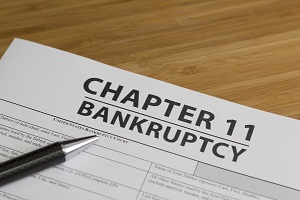Was Your Small Business Financially Affected By The Pandemic?
What Is A Subchapter 5 & What Does It Do?
A Subchapter 5 is a subsection of Chapter 11 bankruptcy, so, when we are talking about Chapter 7s and Chapter 13s, those are for individuals and families who wish to file a bankruptcy.
A business, and when we’re talking about a small business, we’re talking about a business that has been registered with the State as an LLC, a PLLC, S Corp, C Corp, those kinds of business entities, and those business entities carry their debt separate and apart from what the owners might carry, so a small business could file bankruptcy.
They could file a Chapter 7 bankruptcy, where they liquidate what they have, and then, the trustee takes care of those assets, sells them off, and pays their creditor, but a small business cannot file a Chapter 13 bankruptcy, that’s reserved for families and individuals.
We have Chapter 11 bankruptcy, and Subchapter 5 is a subchapter of Chapter 11 bankruptcy, and it’s intended for corporations, LLCs, and PLLCs, which make Chapter 11s a little cheaper, easier, and more streamlined than regular big enormous Chapter 11s. It’s for small businesses that want to keep operating but with less debt weighing them down.
It’s a reorganization of business entities.
Is There A Reason Why Subchapter 5 Is Connected To Chapter 11?
Adding a Chapter to the bankruptcy code is complicated; it takes an act of Congress to be able to do that.
Chapter 11 is already in place and it seems to do the job pretty well, with some exceptions.
In this situation, Congress just needed to tweak Chapter 11 and add a subchapter there, to make it just a little bit more manageable for the small businesses in this country.
What Does A Restructuring Process Under Subchapter 5 Look Like?
Like in the other Chapters, a small business (and we’re going to call the business the debtor because they’re the ones in debt, they’re the ones filing the bankruptcy) files a bankruptcy petition with the bankruptcy court, that’s how every bankruptcy gets kicked off.
This petition has schedules attached to it that list all the debt, all the assets, and the value of all the assets.
Then, in Subchapter 5, the small business has 90 days that can be extended, but in general, it’s 90 days to file a proposed plan of reorganization.
There’s a trustee that gets assigned to help with that process, but the small business will file this plan that proposes to pay these creditors, in this way, maybe discharge other kinds of debt, and then we’re off to the races.
Once that plan is filed, then, we know how we’re going to try to get out of this debt.
Is There A Debt Limit That A Debtor May Face When Filing A Subchapter 5?
The debtor cannot have more than two million seven hundred twenty-five thousand six hundred twenty-five dollars in combined, secured, and unsecured debt.
Now, during the pandemic, Congress raised that debt limit to 7.5 million dollars, it was supposed to expire in 2021, it got extended once, and then, it expired in April of this year, so now we’re back to the original amount of 2.725 million dollars.
Does Subchapter 5 Make Any Change To The Ownership Of A Business?
No, and that’s one of the beauties of it. In Chapter 11, a business owner can continue to own the business, it’s called a debtor in possession.
Chapter 11 sometimes will have somebody else run the small business for a time being, that’s a whole different situation, but in Subchapter 5, the debtor can remain the debtor in possession.
On the first day of filing a bankruptcy petition for a Chapter 11, several motions must be filed as soon as the bankruptcy is filed, cleverly these are called first-day motions, and getting approval for the ownership to stay with the debtor is one of those first day motions.
How Do Creditors & Debtors Benefit When A Business Owner Files A Subchapter 5?
As debtor-side attorneys, we always like to see the bright side of our clients. The debtors benefit because they get protection from lawsuits, they get protection from repossession, they get protection from collection activity, that’s the automatic stay.
They can remain in business, they don’t have to shut their doors forever.
Knowing that there is this Chapter 5 that is available to debtors, should motivate creditors to work things out outside of bankruptcy, or outside of a receivership because, then, they run the risk of not getting their full payment or not getting any payment in bankruptcy.
Hopefully, the creditors know that this exists, and they’re motivated to work something out.
The creditors do benefit though under this plan because they know they can get paid, they can rely on this court-approved plan of repayment, and then, there are very structured resources available to them, if part of the plan is not fulfilled.
Can Any Business Qualify For A Subchapter 5?
Not any small business, must have debt, less than the debt limit that we just talked about, and of that debt, at least half of it has to be business debt, it can’t be personal debt.
They also must be able to afford that repayment plan, that’s what the plan is, it’s a proposal for how they’re going to repay for up to 5 years.
For a small business that is sinking that can’t afford any kind of repayment, we might have to have a tough conversation about liquidation, and what’s in the best interest of the business.
If they cannot afford a repayment plan, it probably won’t be a good idea or a very successful Subchapter 5.
What Are The Pros & Cons Of Subchapter 5?
The pros are some of the same pros as with any bankruptcy, you get that automatic stay protection, which protects the business from collection activity, including lawsuits and repossessions.
It’s a great way to stay in business while not getting weighed down by your business debt.
Another great thing about Subchapter 5, is that if the owner of the small business has any personal liability for the debt, there’s what’s called co-debtor protection available.
Now, this isn’t true in every case but in most cases, they will be as long as they can show that they are an integral part of the small business, they’re not just a silent partner.
Then, they can get protection from that personal liability.
The cons are that as a small business owner you do have to subject yourself to some oversight from the bankruptcy court, also you have to have your papers up to date so that you can provide documentation and submit reports when necessary.
If you’re operating yoursmall business and you don’t know where your contracts are, it’s kind of a cash business, you don’t know what your cash flow is, it’s going to be hard to be successful in Subchapter 5.
There’s the perceived damage to your reputation, and we always say perceived because there’s this idea that bankruptcy is a failure, but in reality, it’s just a financial strategy.
For example, there’s a restaurant near that we like, and they had two locations, they filed bankruptcy, and just seeing the headline, it didn’t tell us any of the information we wanted to know as a bankruptcy lawyer in Austin, because they’re writing for the public.
While at first there may have been some damage to their reputation, it wasn’t long-lasting, but they did recover and they’re doing very well now.
Could I File For A Small Business Bankruptcy & A Personal Bankruptcy At The Same Time?
Absolutely. There are a couple of different ways that we would look at this, and the contracts with the debt will be important to review and then what kind of bankruptcy gets filed.
Sometimes small business owners have personal liability on some of these loans.
We recently filed a bankruptcy for a dental practice, and the owner co-signed with personal liability for the entire debt.
She decided to file a Chapter 7 liquidation bankruptcy, but Chapter 7 does not protect her as an individual, so we are also filing a personal bankruptcy for her so that she can get rid of that personal liability on the business debt.
In Subchapter 5, if it’s a personal liability on the small business debt, then, the individual also gets that coder protection, as long as they’re part of the small business and actively participating in the business.
As there is protection, it might not be necessary for any personal liability of small business debt.
If the owner of the business just has regular debt, if their car broke down, they can’t use it anymore, they want to surrender it and file for bankruptcy, or if they have a lot of medical debt as a lot of people do, yes, absolutely they can file personal bankruptcy, and the small business can file a bankruptcy.
In your bankruptcy, you’ll have to list that you have been a business owner, and you’ll have to tip the balance sheets.
You’ll have to show that business’s assets and liabilities, so it gets a little tangled up but yes, absolutely possible.
How Long Would A Subchapter 5 Process Take To Be Approved?
The approval process that’s not a term we use in bankruptcy. it depends on what we mean by approved.
It takes 90 days or more for the plan to be filed, the proposed repayment plan, and then, there’s a period for the creditors to review the plan, and if they want to object, they can, but eventually, the court will confirm the plan.
In that sense, if the plan is approved, then it’s approved.
Ultimately though the plan must be carried out within 3 to 5 years, so if we’re talking about completion, then that’s when it’s approved.
What Happens If The Request To File Subchapter 5 Is Denied?
Like with all bankruptcies, filing a petition is not a request, you’re not asking for anybody’s permission, it doesn’t get accepted or denied, and it’s presumed valid when you file it.
It’s up to other parties to object to different parts of it, or they might object to the whole discharge of the whole debt, if they can prove it was filed in bad faith or some other reason you might get an objection to discharge.
You’re presumed to have filed it in good faith.
Another situation is the treatment of the debt. A creditor might object to the plan saying: No, we should get a bigger percentage; This is a secured debt, so we should get all of it; The value of the security agreement is higher.
In that sense, they can object to one piece of the debt. Alternatively, the debtor may not follow through with the provisions of the plan, and the court could just dismiss the case, it’s not a rejection of a request, it’s a dismissal of the case, they could dismiss it entirely.
If these things happen, the debtor does have a chance to argue against it.
If the court then rules against the debtor, then yes, appeals are always available to the debtor, you would need to find a really good foundation for the appeal though.
Can Subchapter 5 Be Improved In Bankruptcy?
Subchapter 5 is very very new, it was approved by Congress in 2019 and only enacted in 2020.
We all remember how 2020 went, nothing has been normal since then, we know that small businesses have been especially impacted by the pandemic, but it’s too soon to tell how Subchapter 5 can be improved.
& Let’s Discuss How We Can Best Help Eliminate Your Specific Financial Struggles!






